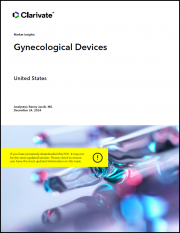
|
시장보고서
상품코드
1577076
여성용 의료기기 시장, 시장 기회, 성장 촉진요인, 산업 동향 분석과 예측(2024-2032년)Women Health Devices Market, Opportunity, Growth Drivers, Industry Trend Analysis and Forecast, 2024-2032 |
||||||
세계의 여성용 의료기기 시장은 2023년에 약 1,299억 달러로 평가되며, 2024-2032년 CAGR 9.2%로 성장할 것으로 예측됩니다.
여성용 의료기기에는 여성 특유의 건강 상태를 진단, 모니터링 및 치료하기 위해 고안된 의료기기, 장비 및 툴이 포함됩니다. 이러한 기기들은 사춘기부터 폐경기, 그리고 그 이후까지 여성의 해부학적, 생리적 요구를 충족시키기 위해 다양한 생애 단계에 걸쳐 사용됩니다. 생식 건강, 부인과 진료, 유방암, 자궁경부암, 골다공증, 골반저 질환 등의 증상을 다루고 있습니다. 전 세계에서 고령화, 특히 여성의 고령화로 인해 요실금 문제가 증가하고 있습니다. 요실금은 골반저근의 약화로 인해 발생하는 경우가 많으며, 미국에서는 약 2,500만 명의 성인이 요실금에 시달리고 있고, 그 중 75-80%가 여성이며, 전 세계에서 약 2억 명이 요실금에 시달리고 있습니다.
여성용 의료기기 시장은 기기와 소모품으로 나뉩니다. 기기 분야에는 피임기구, 불임 모니터링 툴, 생리 건강 제품, 유방 및 골반 건강 제품, 임산부 건강 제품, 일반 건강 모니터, 부인과 의료기기 등이 포함됩니다. 이 분야는 2032년까지 2,114억 달러에 달할 것으로 예측됩니다. 이러한 성장을 가속하는 몇 가지 요인은 여성 건강에 대한 인식 증가, 전용 기기의 출현, 효율적이고 사용하기 쉬운 제품을 생산하는 기술 발전, 예방적 헬스케어로의 사회적 변화 등 여러 가지가 있습니다.
시장은 암, 골다공증, 감염, 자궁근종, 임신, 여성 피임, 월경 장애 등의 분야로 나뉩니다. 감염 분야는 분석 기간 중 연평균 7.9%의 연평균 복합 성장률(CAGR)로 성장할 것으로 예상됩니다. 요로감염증(UTI), 성병(STI), 질감염증 등 여성에게 발생하는 감염성 질환이 전 세계에서 유행하고 있습니다. 예를 들어 세계보건기구(WHO)는 2022년 2,000만 명의 여성이 HIV 양성 반응을 보였고, 54만 명이 새로 감염되었으며, 23,000명이 관련 사망한 것으로 보고하고 있습니다.
미국에서는 2032년까지 여성용 의료기기 시장 규모가 788억 달러에 달할 것으로 예상됩니다. 여성 건강과 예방 의료에 대한 인식이 높아지면서 전용 기기에 대한 수요가 증가하고 있습니다. 특히 유방암과 골다공증에 대한 정기 검진 및 조기 진단을 장려하는 노력은 이러한 성장을 더욱 촉진하고 있습니다. 기타 성장 촉진요인으로는 의료비 지출 증가, 정부 지원 정책, 의료 기술 발전, 생활습관병 유병률 증가 등을 들 수 있습니다. 이러한 요인들이 복합적으로 작용하여 여성 건강관리의 접근성과 질이 향상되면서 시장이 확대되고 있습니다.
목차
제1장 조사 방법과 조사 범위
제2장 개요
제3장 업계 인사이트
- 업계에 대한 영향요인
- 촉진요인
- 선진국에서 여성 질병 부담의 증가
- 세계의 여성 고령자 인구의 증가
- 헬스케어 산업에서 기술의 진보
- 개발도상국에서 여성 건강에 관한 의식의 향상
- 업계의 잠재적 리스크 & 과제
- 기기 및 시술의 고비용
- 저개발 국가에서 여성의 의식 결여
- 촉진요인
- 성장 가능성 분석
- 기술 전망
- 향후 시장 동향
- 규제 상황
- Porter의 산업 분석
- PESTEL 분석
제4장 경쟁 구도
- 서론
- 기업 점유율 분석
- 주요 시장 기업의 경쟁 분석
- 경쟁 포지셔닝 매트릭스
- 전략 전망 매트릭스
제5장 시장 추산·예측 : 제품별, 2021-2032년
- 주요 동향
- 기기
- 피임 기기
- 수태 가능성 모니터링 기기
- 생리 용품
- 유방용 건강 기기
- 골반용 건강 기기
- 산모 건강 기기
- 일반 건강 모니터링 기기
- 부인과 질환용 의료기기
- 기타 기기
- 소모품
제6장 시장 추산·예측 : 용도별, 2021-2032년
- 주요 동향
- 암
- 골다공증
- 감염증
- 자궁근종
- 임신
- 여성 불임 수술
- 월경 장애
- 기타 용도
제7장 시장 추산·예측 : 최종사용자별, 2021-2032년
- 주요 동향
- 병원
- 산부인과 클리닉
- 진단 연구소
- 외래 수술 센터
- 기타 최종사용자
제8장 시장 추산·예측 : 지역별, 2021-2032년
- 주요 동향
- 북미
- 미국
- 캐나다
- 유럽
- 독일
- 영국
- 프랑스
- 이탈리아
- 스페인
- 러시아
- 덴마크
- 스웨덴
- 기타 유럽
- 아시아태평양
- 중국
- 일본
- 인도
- 호주
- 한국
- 기타 아시아태평양
- 라틴아메리카
- 브라질
- 멕시코
- 아르헨티나
- 기타 라틴아메리카
- 중동 및 아프리카
- 남아프리카공화국
- 사우디아라비아
- 아랍에미리트
- 카타르
- 기타 중동 및 아프리카
제9장 기업 개요
- Abbott Laboratories
- Allengers Medical
- Alphabet Inc.
- Caldera Medical
- Carestream Health
- Garmin Ltd.
- GE Healthcare Technologies Inc.
- Hologic, Inc.
- Koninklijke Philips N.V.
- Mankind Pharma Limited
- OMRON Corporation
- Organon and Co.
- Samsung Electronics co., Ltd.
- The Cooper Companies, Inc.
The Global Women Health Devices Market was valued at approximately USD 129.9 billion in 2023 and is projected to grow at a CAGR of 9.2% from 2024 to 2032. Women's health devices include medical instruments, equipment, and tools designed for diagnosing, monitoring, and treating health conditions unique to women. These devices address the anatomical and physiological needs of women throughout various life stages, from adolescence to menopause and beyond. They cover reproductive health, gynecological care, and conditions like breast cancer, cervical cancer, osteoporosis, and pelvic floor disorders. The aging global population, particularly among women, is increasing urinary incontinence issues. This condition, often due to weakened pelvic floor muscles, affects about 25 million adults in the U.S., with 75-80% being women, and around 200 million worldwide.
The overall women health devices industry is classified based on the product, application, end use r, and region.
The women health devices market is divided into devices and consumables. The devices segment includes contraceptive devices, fertility monitoring tools, menstrual health products, breast and pelvic health devices, maternal health products, general health monitors, gynecological medical devices, and more. Forecasts suggest this segment will reach USD 211.4 billion by 2032. Several factors drive this growth: heightened awareness among women about their health needs, the emergence of specialized devices, technological advancements yielding efficient and user-friendly products, and a societal shift towards preventive healthcare.
The market is divided into areas like cancer, osteoporosis, infectious diseases, uterine fibroids, pregnancy, female sterilization, and menstrual disorders. The infectious diseases segment is set to grow at a CAGR of 7.9% during the analysis period. Infectious diseases affecting women, such as urinary tract infections (UTIs), sexually transmitted infections (STIs), and vaginal infections, are globally prevalent. For instance, the WHO reported in 2022 that twenty million women were HIV-positive, with 540,000 new cases and 23,000 related deaths.
In the U.S., the women health devices market is projected to reach USD 78.8 billion by 2032. Heightened awareness about women's health and preventive care drives the demand for specialized devices. Initiatives promoting regular screenings and early diagnoses, especially for breast cancer and osteoporosis, further fuel this growth. Other growth drivers include rising healthcare expenditures, supportive government initiatives, medical technology advancements, and the increasing prevalence of lifestyle-related diseases. Together, these factors enhance women's healthcare accessibility and quality, expanding the market.
Table of Contents
Chapter 1 Methodology and Scope
- 1.1 Market scope and definitions
- 1.2 Research design
- 1.2.1 Research approach
- 1.2.2 Data collection methods
- 1.3 Base estimates and calculations
- 1.3.1 Base year calculation
- 1.3.2 Key trends for market estimation
- 1.4 Forecast model
- 1.5 Primary research and validation
- 1.5.1 Primary sources
- 1.5.2 Data mining sources
Chapter 2 Executive Summary
- 2.1 Industry 360° synopsis
Chapter 3 Industry Insights
- 3.1 Industry impact forces
- 3.1.1 Growth drivers
- 3.1.1.1 Increasing disease burden among women in developed countries
- 3.1.1.2 Rising elderly female population worldwide
- 3.1.1.3 Technological advancements in healthcare industry
- 3.1.1.4 Increasing awareness regarding women health in developing countries
- 3.1.2 Industry pitfalls and challenges
- 3.1.2.1 High cost of devices and procedures
- 3.1.2.2 Lack of awareness among women in underdeveloped economies
- 3.1.1 Growth drivers
- 3.2 Growth potential analysis
- 3.3 Technology landscape
- 3.4 Future market trends
- 3.5 Regulatory landscape
- 3.6 Porter's analysis
- 3.7 PESTEL analysis
Chapter 4 Competitive Landscape, 2023
- 4.1 Introduction
- 4.2 Company market share analysis
- 4.3 Competitive analysis of major market players
- 4.4 Competitive positioning matrix
- 4.5 Strategic outlook matrix
Chapter 5 Market Estimates and Forecast, By Product, 2021 - 2032 ($ Mn)
- 5.1 Key trends
- 5.2 Devices
- 5.2.1 Contraceptive devices
- 5.2.2 Fertility monitoring devices
- 5.2.3 Menstrual health products
- 5.2.4 Breast health devices
- 5.2.5 Pelvic health devices
- 5.2.6 Maternal health products
- 5.2.7 General health monitoring devices
- 5.2.8 Medical devices for gynecological conditions
- 5.2.9 Other devices
- 5.3 Consumables
Chapter 6 Market Estimates and Forecast, By Application, 2021 - 2032 ($ Mn)
- 6.1 Key trends
- 6.2 Cancer
- 6.3 Osteoporosis
- 6.4 Infectious diseases
- 6.5 Uterine fibroids
- 6.6 Pregnancy
- 6.7 Female sterilization
- 6.8 Menstrual disorders
- 6.9 Other applications
Chapter 7 Market Estimates and Forecast, By End-user, 2021 - 2032 ($ Mn)
- 7.1 Key trends
- 7.2 Hospitals
- 7.3 Obstetrics and gynecology clinics
- 7.4 Diagnostic laboratories
- 7.5 Ambulatory surgical centers
- 7.6 Other end-users
Chapter 8 Market Estimates and Forecast, By Region, 2021 - 2032 ($ Mn)
- 8.1 Key trends
- 8.2 North America
- 8.2.1 U.S.
- 8.2.2 Canada
- 8.3 Europe
- 8.3.1 Germany
- 8.3.2 UK
- 8.3.3 France
- 8.3.4 Italy
- 8.3.5 Spain
- 8.3.6 Russia
- 8.3.7 Denmark
- 8.3.8 Sweden
- 8.3.9 Rest of Europe
- 8.4 Asia Pacific
- 8.4.1 China
- 8.4.2 Japan
- 8.4.3 India
- 8.4.4 Australia
- 8.4.5 South Korea
- 8.4.6 Rest of Asia Pacific
- 8.5 Latin America
- 8.5.1 Brazil
- 8.5.2 Mexico
- 8.5.3 Argentina
- 8.5.4 Rest of Latin America
- 8.6 Middle East and Africa
- 8.6.1 South Africa
- 8.6.2 Saudi Arabia
- 8.6.3 UAE
- 8.6.4 Qatar
- 8.6.5 Rest of Middle East and Africa
Chapter 9 Company Profiles
- 9.1 Abbott Laboratories
- 9.2 Allengers Medical
- 9.3 Alphabet Inc.
- 9.4 Caldera Medical
- 9.5 Carestream Health
- 9.6 Garmin Ltd.
- 9.7 GE Healthcare Technologies Inc.
- 9.8 Hologic, Inc.
- 9.9 Koninklijke Philips N.V.
- 9.10 Mankind Pharma Limited
- 9.11 OMRON Corporation
- 9.12 Organon and Co.
- 9.13 Samsung Electronics co., Ltd.
- 9.14 The Cooper Companies, Inc.



















